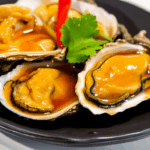Stir-Fried Basil with Fresh Shrimp – A Fujian Delicacy
Introduction:
Fujian Province, located on the southeast coast of China, is renowned for its rich culinary traditions. Among the myriad of dishes that have originated from this region, stir-fried basil with fresh shrimp stands out as a classic and beloved dish. This dish not only captures the essence of Fujianese cooking but also showcases the province’s deep connection to its coastal environment. In this article, we will delve into the history, preparation, and significance of this delectable dish.
History and Cultural Significance
The origins of stir-fried basil with fresh shrimp can be traced back several centuries in Fujian Province. The dish emerged as a result of the region’s abundant marine resources and the influence of various foreign cultures, particularly those from Southeast Asia. Basil, a herb that was introduced to Fujian through trade routes, quickly became an integral part of local cuisine. Its aromatic leaves paired perfectly with the succulent shrimp, creating a harmonious blend of flavors that resonates with the tastes of the Fujianese people.
In addition to its culinary importance, this dish holds cultural significance. It is often served during festive occasions and family gatherings, symbolizing prosperity and good fortune. The vibrant green color of the basil leaves and the bright red hue of the shrimp represent vitality and health, making it a visually appealing choice for celebrations.
Ingredients
To prepare this dish, you will need the following ingredients:
- 1 lb (450g) fresh shrimp, peeled and deveined
- 1 bunch fresh basil, leaves separated
- 3 cloves garlic, minced
- 1 tablespoon ginger, finely chopped
- 1 teaspoon sesame oil
- 2 tablespoons soy sauce
- 1 teaspoon sugar
- 1 teaspoon oyster sauce
- 1 teaspoon rice wine or dry sherry
- 1 tablespoon cornstarch mixed with 2 tablespoons water
- Salt and pepper to taste
- Vegetable oil for frying
Preparation Steps
- Prepare the Shrimp: Rinse the shrimp under cold running water and pat them dry with paper towels. If the shrimp tails are still attached, you may choose to leave them intact for presentation purposes.
- Marinate the Shrimp: In a bowl, combine the shrimp with the minced garlic, chopped ginger, sesame oil, soy sauce, sugar, oyster sauce, rice wine, and a pinch of salt and pepper. Toss gently to ensure all shrimp are evenly coated. Let the mixture sit for about 15 minutes to allow the flavors to meld together.
- Heat the Wok: Heat a wok over high heat until it is very hot. Add enough vegetable oil to coat the bottom of the wok, then add the marinated shrimp. Stir-fry the shrimp for about 2-3 minutes until they turn pink and opaque. Remove the shrimp from the wok and set aside.
- Stir-Fry the Basil: In the same wok, reduce the heat to medium-high and add another tablespoon of vegetable oil if needed. Add the basil leaves and stir-fry for about 1 minute until the leaves just begin to wilt but still retain their bright green color.
- Combine and Finish: Return the shrimp to the wok along with any remaining marinade. Add the cornstarch slurry and stir-fry everything together for another 1-2 minutes until the sauce thickens slightly. Taste and adjust seasoning if necessary. Serve immediately.
Cooking Tips
Choosing the Right Shrimp: For the best results, use fresh shrimp that are firm and have a sweet aroma. If possible, opt for wild-caught shrimp as they tend to have a more robust flavor compared to farmed varieties.
Handling Basil: Basil is a delicate herb that can easily become bitter if overcooked. Therefore, it is crucial to stir-fry the basil leaves briefly to preserve their freshness and flavor. Avoid overcrowding the wok, as this can cause the leaves to steam rather than sear.
Balancing Flavors: The key to a well-balanced dish lies in the harmony between sweet, salty, and umami flavors. Adjust the amount of sugar, soy sauce, and oyster sauce according to your personal preference. Additionally, adding a small amount of rice vinegar can enhance the overall brightness of the dish.
Serving Suggestions
This dish pairs wonderfully with steamed rice or noodles. You can also serve it alongside other Fujianese specialties such as braised tofu or pickled vegetables to create a complete meal. For a refreshing contrast, consider adding a side of cucumber salad or a simple tomato soup.
Nutritional Information
Per serving (assuming 4 servings):
| Calories | Protein | Fat | Carbohydrates | Sodium |
|---|---|---|---|---|
| 250 kcal | 30 g | 8 g | 10 g | 500 mg |
Conclusion
Stir-fried basil with fresh shrimp is more than just a dish; it is a testament to the culinary ingenuity and cultural heritage of Fujian Province. By mastering this recipe, you not only enjoy a delicious meal but also gain insight into the rich tapestry of Chinese gastronomy. Whether you’re a seasoned cook or a novice in the kitchen, this dish promises to be both rewarding and enjoyable to prepare. Bon Appétit!


